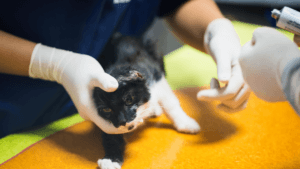
Cats have a reputation for being independent, aloof, and carefree. Many are quite the opposite, but they still often prefer to have things their way. But when your feline friend is in the midst of a medical emergency, they need your help – whether they’d normally welcome it or not.
Medical emergencies for cats often look different than they do for dogs – there’s usually no yelping in pain, excessive whining, or limping. That’s because cats are experts at hiding their pain. So understanding some common emergencies and learning what to do if you suspect one is happening can help make the difference when every minute matters.
Here are the most common feline emergencies we treat here at Burleson Animal Emergency Hospital:
Pyrethrin Toxicity
Pyrethrin is a chemical most often found in topical dog flea and tick preventives – those applied to a dog’s skin. While not harmful to canines, it is poisonous to cats if it gets onto their skin. Merely coming into contact with it, even a small amount, can cause severe illness.
- Signs and symptoms: Cats experiencing pyrethrin toxicity may shake uncontrollably, stumble about as though drunk, or exhibit seizures.
Urethral Obstruction
Male cats especially are prone to this condition, in which the urethra, the tube draining urine from the bladder, becomes obstructed by crystals, small kidney stones, or other matter.
- Signs & symptoms: Affected cats may cry while urinating, strain to urinate, or urinate outside the litter box. Failure to urinate means the blockage is complete, and your cat needs emergency care immediately.
Saddle Thrombus
A saddle thrombus is a blood clot that lodges at the base of the aorta in the heart where it branches into two arteries, obstructing blood flow to the hind limbs. The clot often forms as a result of heart disease, which can be difficult to diagnose and often goes unnoticed in cats for long periods.
- Signs & symptoms: Symptoms reflect the sudden onset of pain and paralysis, including crying, hiding, panting or breathing rapidly, and an inability to use the hind limbs.
Pleural Effusion
Pleural effusion occurs when fluid accumulates in a cat’s chest cavity – not in the lungs themselves, but surrounding them, in the pleural sac. The fluid takes up space and makes it more difficult for the lungs to expand, causing shortness of breath and decreased oxygen intake. Pleural effusions can be caused by anything from cancer to heart failure, so diagnosing the condition and determining the cause is essential to successful treatment.
- Signs & symptoms: Cats with pleural effusion often display rapid, shallow breathing or breathe with their mouths open to try and get more air.
Hypertension
Hypertension is a more technical name for high blood pressure, and in cats, it’s often a result of thyroid, heart, or kidney disease. Older and overweight cats are more susceptible to the conditions that cause hypertension, so they are at higher risk than other felines.
- Signs and symptoms: One of the most common signs of hypertension is blindness, as increased blood pressure in the eyes can cause the retinas to detach. The cat may bump into things or appear confused and unsure of her surroundings. Other signs can include those associated with the underlying illness, such as weight loss, vomiting, or seizures.
Congestive Heart Failure (CHF)
Congestive heart failure occurs when the heart cannot pump enough blood to the body. It’s most often a result of hypertrophic cardiomyopathy in cats, a condition where the heart muscle thickens.
- Signs and symptoms: Unfortunately, symptoms are often not seen until the condition is advanced, and they’re often easily missed: lethargy, weight loss, anorexia, sudden collapse, or hind limb lameness.
What To Do in an Emergency
If you suspect your cat is in pain or having a medical emergency, call your nearest emergency animal hospital immediately. They can advise you on the safest course of action, including whether your cat should be transported.
Cats in pain may display aggression, so always be careful and gentle when attempting to move them. If your cat will let you pick her up, get her into her carrier or a closed box for the trip to the emergency hospital. If your cat is reluctant to come out of hiding, you may need to wrap her in a towel – again, being as gentle as possible – to get her into the carrier. While driving to the animal hospital, try to keep your furry friend calm, still, and comfortable.
Burleson Animal Emergency Hospital is Open 24/7/365
At Burleson Animal Emergency Hospital, our experienced and highly trained team of emergency veterinarians and technicians are available to provide comprehensive and compassionate care for your cat – and dog – any time day or night.
If you believe your pet is having a medical emergency, please contact our team immediately at (817) 900-2000. We will prepare for your arrival and discuss our current safety protocols.